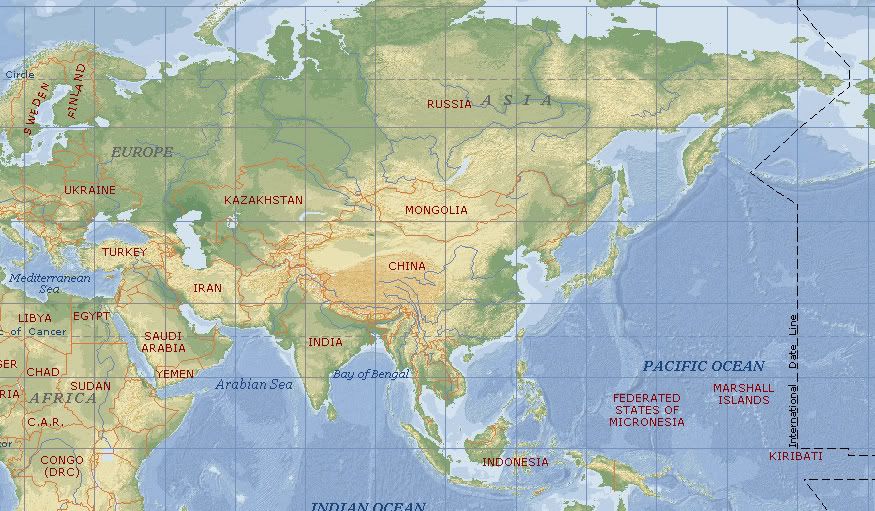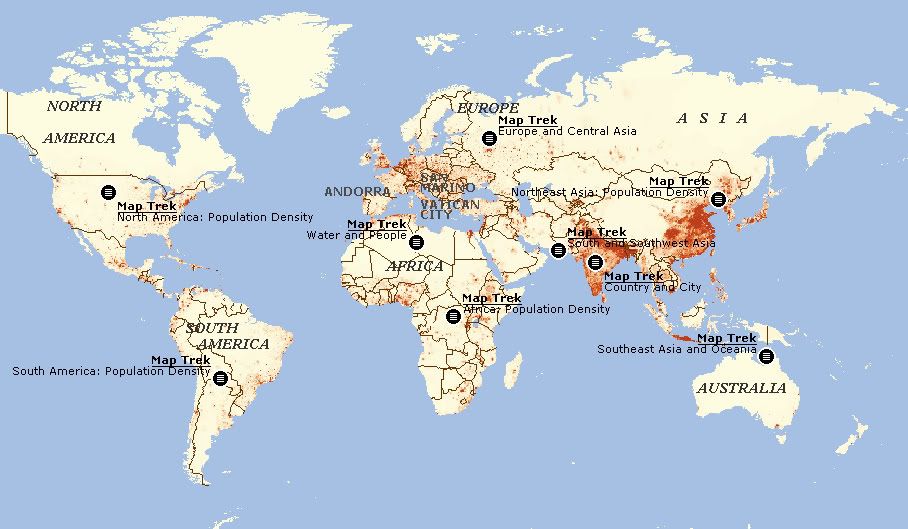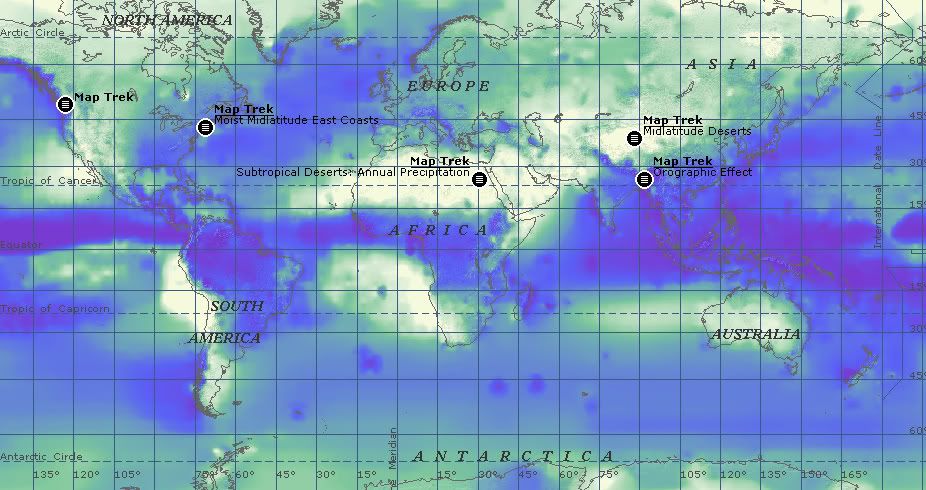Finally, i got around to taking photos of the maps that you made. Everyone did a great job. Your maps are more than what i expected given the limitations particular to each section.
Here's a short media presentation of our past activities. Enjoy!
N4C deserves special mention for abiding with our agreement the week prior to our map making activity. They finished the map at least on the same day of the map making activity. Because N4A and N4B begged off on our agreement, i think it would be fair that the prize, whatever it may be (wink, wink!), should go to N4C.
Nevertheless, everyone gets high merit for excellent work not only on your maps but in our "Show and Tell Asia!" activity too.
Keep up the good work!
Read more!
Wednesday, July 11, 2007
Great Work Everyone!
Posted by
Patrick
at
4:34 PM
6
comments
![]()
Labels: asia geography, asia maps, bamboo grove, class tasks, doughnut question
Friday, July 6, 2007
Of toponyms, demonyms, and etymology
Flo Adriano asked a very interesting question about the term "Asia". Specifically, she asks in her comment to "I got you thinking about the reason for the groupings...hahaha!":
why is the continent of Asia, called "ASIA"? what's the history behind it's name?
why is the continent of asia named as "ASIA"? who gave the name?
The term "Asia" may be traced to Ancient Greece when the Greek historian Herodotus first used it in reference to Anatolia and/or the Persian Empire in his account of the Persian Wars. The etymological roots of the word, however, might also be found in the Akkadian language.
Clicking here will bring you to the relevant information on Wikipedia.
More interesting is the common usage of "Asian". Colloquially, it is used to refer to people from a sub-region of Asia. In other words, people don't use it to refer to a person who comes from the Asian continent. Rather, it is used in reference to a person or persons from a culturally distinct sub-region of the Asian continent. In the United States the term is commonly associated with East Asians, while the British associate it with South Asians. Over time, it has also grown in scope to include Southeast Asians.
This reinforces the premise that the Asian continent can be separated into two distinct cultural realms. One part is obviously asian and the other is not.
Everyone is encouraged to do more research on this topic so we can add more information and sources.
Read more!
Posted by
Patrick
at
9:37 AM
0
comments
![]()
Labels: demonym, etymology, Origin of the term "Asia", toponym
Thursday, July 5, 2007
I got you thinking about the reason for the groupings ... hahaha!
Mission accomplished!
To be honest, i wanted you to think about the reason for the class groupings. Yes! It has something to do with the population density. Yes! It has something to do with the rainfall and weather/climate (in general). And by implication, YES! That's what's so unique about the portion of the Asian continent that we are going to study this semester.
In a previous post i mentioned that Asia is usually divided into five realms that follow their general locational groupings on a map. In addition, we can also divide asia into two broad cultural realms: one that is distinctly asian in culture and character; another realm which is not. Simple!
Since this is an Asian studies course we will obviously explore the asian realm of the Asian continent. The four groupings coincide with what we may refer to as Monsoon Asia that includes the following realms: East Asia, South Asia and Southeast Asia. But then, why only the civilizations of India, China, Japan, Korea and those that emerged in Southeast Asia? Not only did these civilizations achieve so much and accomplish so much over such a long period, we have to understand also that for thousands of years they had plenty of what westerners longed for. Ever wonder why westerners colonized so many areas in Asia?
You might also be wondering how this (some say sharp) cultural distinction emerged in one continent. Europe for instance, while composed of several nations (we all know the difference between nation and country, i hope), has what might be considered a wholeness in its history. For instance, one cannot study the history of France without touching upon the histories of other european nations. Inevitably the historical links will lead you to look at Europe with broader historical eyes.
The same historical connections and relationships can also be found in the Asian realm (but not throughout the Asian continent). Thus, we study Monsoon Asia not only as an area comprised of different nations but also as a larger unit of study with inter-related histories. Or at least we will try to for one semester (hoping that your teacher's laziness will not worsen ... is that a smile?)
What makes Monsoon Asia so distinct not only from the rest of the Asian continent but from the rest of the world? In "Where in the World is Asia?" i showed you two maps: population density and rainfall. The maps partly explain how the uniquely asian character of Monsoon Asia evolved.
3.73 billion people live in this part of the world! That's 3/5 of the world's population. Put together plenty of people in such a small space and for sure they will evolve their own ways of dealing with social pressure. But why didn't these people disperse all over the continent? Well, you might be surprised to know that Monsoon Asia is the most agriculturally productive region in the world. It has been this way for a long time and continues to be productive to this day. But the biggest problem in this part of the world is that the population is so huge and growing at such a fast rate that agricultural production really cant keep up with the demand - wonder why there are many who go hungry in asia?
Thus, we have two important features of Monsoon Asia: population density and agriculture. The former feeds off the productivity of the latter. The latter is productive not only because of the fertile soil but also because of the more than adequate rainfall. Everyone knows that water is important in agriculture.
What we have to realize is that because of population density and the requirements of an agriculture-based society, Asians have their own way of viewing and dealing with the world. And while there are differences that exist among the many Asian nations, the impact of population density and the agrarian base is common across all of Monsoon Asia. From here it is not difficult to see that Asians share common cultural patterns that are often fundamentally different from what you will find in the west.
Read more!
Posted by
Patrick
at
9:24 AM
3
comments
![]()
Labels: agrarian base, common cultural patterns, Monsoon Asia as a unit of study, population density
Wednesday, July 4, 2007
What others are saying? - "Alien nation"
This is an interesting look into an often unexplored facet of Philippine society (and culture?) . So many Filipinos want to leave and yet there are so many others who find the Philippines so attractive a destination. Some even forget about leaving. This "Alien Nation" i-report series by PCIJ promises to be interesting and provocative. More importantly, related to some class learning goals formulated by the N4C India group (just scroll to the bottom of the post to find out).
"Tisoy Kasi!" is a broad and informed look by Dr. Michael Tan at the hybrid Filipino culture and our syncretic religious practices.
This PCIJ series is a good starting point for asian studies. In part because it is a view from inside looking in, but mostly because it promises to bring us within ourselves as Asians and not as what westerners would want us to see ourselves. As we begin our discussions of the major civilizations, hopefully, you will realize one common thread in Asian culture - more often Asians have chosen to adopt from other cultures and practices what works instead of trying to subdue other cultures and impose our own on them.
Of note is the syncretic nature of religious practice in a lot of Asian civilizations notably hinduism in India. (ooops! India Group this is your area ... research?) or even the curious mixed practice of Taoism and Confucianism in China. Even Japan has its own syncretic fusion of religious practice.
Read more!
Posted by
Patrick
at
11:02 AM
3
comments
![]()
Labels: alien nation, syncretic religious practice, what others are saying
Wednesday, June 27, 2007
Where in the world is Asia?
Asia is a huge place! It covers an estimated 30% of the world's land area; roughly it is about 44,391,000 square kilometers. It's conventional geographical boundaries are:
On the north: the Arctic Ocean
On the east: the Bering Strait and the Pacific Ocean
On the southwest: the Red Sea and the Mediterranean Sea
On the west is: the Ural Mountains going south tracing the Ural River until you get to the Caspian Sea and then going west along the Caucasus Mountains until you get to the Black Sea But that's only half of the story.
But that's only half of the story.
There are plenty of countries that belong to the Asian continent, which is why it is also divided into several realms: East Asia, South Asia, Southwest Asia, Southeast Asia, "Russian"/Central Asia. Which countries are in the Asian continent? To which realm/sub-division does each country belong?
Our study of major asian civilizations will include only the following areas: East Asia (civilization in China, Japan, Korea), South Asia (civilization in India and those that it influenced and those that emerged in south asia), and Southeast Asia
Why? Well, that's one of the tasks i gave you this week. I expect that next meeting you will have an idea of why i chose only those four. Here are a few images to give you clues on how to approach the task. This is a population density map of the world. The more red you see, the higher the population density.
This is a population density map of the world. The more red you see, the higher the population density.
This is a rainfall map of the world. Again, the deeper the blue, the more rainfall that place gets in a year.
These images should set your minds twirling. What's so distinct about the parts of the Asian continent that we are going to study in relation to these images?
Read more!
Posted by
Patrick
at
10:43 AM
8
comments
![]()
Labels: asia geography, asia maps
Monday, June 25, 2007
Reaction to your comments
Overall, this first week of our blogging has been uplifting and encouraging for me (and hopefully for you too). I appreciate so many of your comments. Perhaps the following best summarizes your comments and thoughts about our blogging approach
First, a lot of you are new to blogging and are therefore enthusiastic to learn about it. I am very pleased that you are eager to learn and are actually trying to learn how to blog. As Alan B. puts it in his comment:
an excellent idea for learning..!
something to do with computer orientaion in preparation to see, work, and live in a greener pasture
In some way, that was part of my reason for doing this too. I can't keep on dealing with you in the traditional way, when i myself believe that there is some other way of engaging you better. I hope this it. When you get into the real world, you will have to know a little about these things so you wont have a hard time catching up with the rest of your cohorts around the world.
Second, you are now interested in Asian Civ and hopefully, willing to do all my work for me (bwahahaha). This means you will look at the class learning goals and then work towards accomplishing them yourselves with only a little help from me (I hope no more help from me so i can continue with my lazy ways).
Third, your answers to the "doughnut" question are also interesting. Some are comical, some are serious, some are way off topic. I'm just glad that some of you took time to think up an answer to the question itself (instead of merely poking fun at the question). Flo Adriano merits special mention for her research on doughnut history, although next time if you're going to make that long a comment, post it instead. Comments, i think, ought to be short and concise ... oh well, to each their own.
Read more!
Posted by
Patrick
at
5:37 PM
6
comments
![]()
Labels: approach, doughnut question, reactions
Thursday, June 21, 2007
What others are saying
This article from Antonio Abaya is kind of getting ahead of our initial discussions on Asia, but nevertheless relevant to how we want to approach our study of Asia. I have always held the view that too many of us (Filipinos) look to the example of western models on development and modernization and industrialization as if it were an easy thing to do. We need not go far though, other Asian countries have outstripped us in this respect and, thus, deserve not only our admiration but careful consideration of how they did it.
Dare i say that there is an asian model to development? Maybe so. I'm pretty sure that our differences only mean that we have to see ourselves in the same light as other Asians see themselves. Western versus Asian models of development are different because of the fundamental differences in world view.
But this is getting too complicated. We'll take this up again at some point in the future ... we need to lay the groundwork first.
Read more!
Posted by
Patrick
at
8:47 AM
1 comments
![]()
Labels: what others are saying

